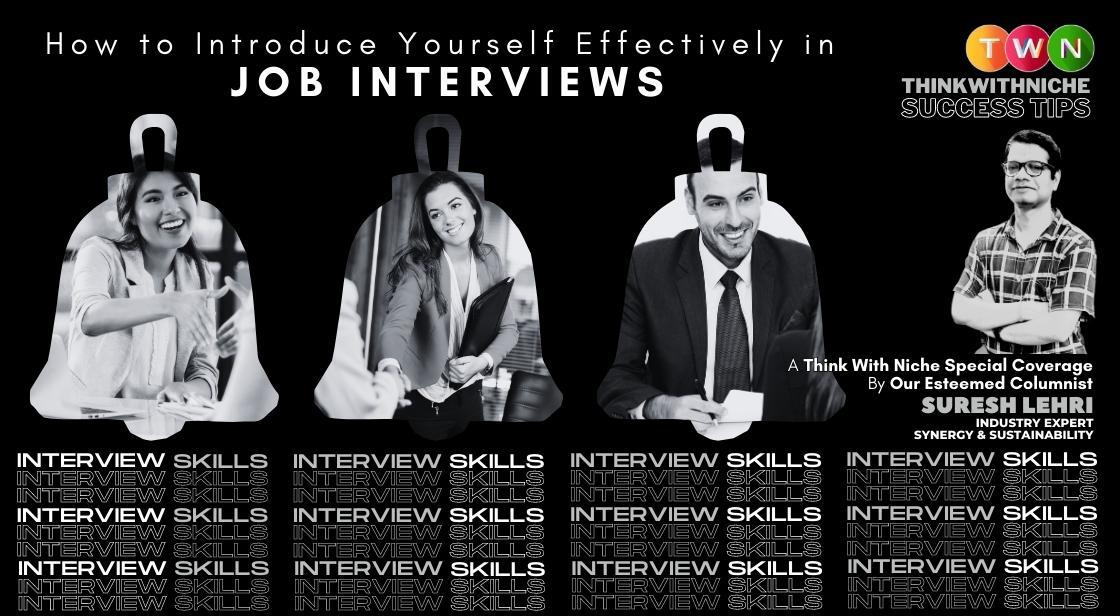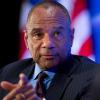How to Introduce Yourself Effectively in Job Interviews

Blog Post
Introducing yourself in a job interview is a crucial moment, a make-or-break opportunity that can set the tone for the entire meeting. Why? Because first impressions matter. They can either open the door to further conversation or shut it before you've even had the chance to showcase your skills.
Ever wondered how to make an unforgettable entrance into a job interview? Picture this - You're seated across from a hiring manager, palms slightly sweaty, heart racing. Well, worry no more because you've just struck gold with this comprehensive guide.
Learn how to introduce yourself effectively and leave a lasting impression.
Why is the Introduction so Crucial?
Your introduction sets the tone for the rest of your interview. It's your 'elevator pitch', a concise yet powerful statement that encapsulates who you are, your skills, your experiences and why you're the perfect fit for the job. Intrigued? Let's dive straight in.
How to Craft a Stellar Introduction ?
Fear not, we've got your back. We'll take you step by step
! If the thought of introducing yourself in a job interview sends shivers down your spine, you've landed on the right page. We're here to guide you, step by step, on how to Introduce Yourself Effectively in Job Interviews.
Learn how to leverage this crucial moment to your advantage, setting the tone, showcasing your skills, and opening the door to further conversation. Remember, first impressions matter, and this is your make-or-break opportunity to leave a lasting impact.
Have you ever wondered why some people walk into a job interview and walk out with a job offer, while others don't? It's not always about who has the most experience or the best qualifications. Often, it's about who can make the best impression.
Your introduction is your first opportunity to make a memorable impression and set the tone for the rest of the interview. It’s your moment to step into the limelight, command attention, and spark interest in your story.
"First impressions are formed within the first 7 seconds of meeting someone"
The way you introduce yourself can either set you up for success or set you up for failure. So, it's vital to get it right.
But how do you introduce yourself in a way that is confident, engaging, and unforgettable? That's what we're here to uncover.
Whether you're a seasoned professional or a fresh graduate, this guide will provide you with actionable tips to introduce yourself effectively during job interviews. So, sit back, relax, and let's dive in!
How to Introduce Yourself Effectively in Job Interviews
-
Crafting a Memorable Introduction: Make an Impact from the Start
First impressions matter, especially in job interviews. You've got just a few precious seconds to cement your image in the hiring manager's mind - make it count. The way you introduce yourself can set the tone for the entire interview, so it's important to get it right.
Start with the basics
Begin by sharing your name clearly and confidently. Pair it with a warm smile and a firm handshake, if appropriate. Show the interviewer that you're glad to be there and excited about the opportunity to discuss the role.
Bring your experiences to life
Next, share a brief summary of your professional background. Avoid rattling off a laundry list of roles and responsibilities. Instead, focus on the experiences and achievements that directly relate to the job you're applying for.
Example: "I've spent the last five years honing my skills in project management, successfully leading teams and delivering large scale projects on time and within budget."
Showcase your unique value
Remember to highlight what makes you unique. What sets you apart from other candidates? Maybe it's your ability to solve complex problems, or your knack for fostering strong team relationships. Whatever it is, make sure it aligns with the job description and company values.
One distinguishing factor that sets me apart is my capability to harmonize strategic thinking with meticulous execution, allowing me to consistently deliver top-notch results.
"Employers often make a decision about a candidate within the first 90 seconds of an interview."
Make a personal connection
Lastly, don't forget to add a personal touch to your introduction. Mention something you love about the industry or the company, or share a brief personal anecdote that reflects your passion and commitment. This can help establish rapport and make you more memorable to thehiring manager. Remember, being authentic and genuine can make a world of difference in setting you apart from the competition.
-
Understanding the Company and Role: Tailoring Your Introduction
Waltzing into a job interview without doing your homework is like walking into a test without studying. It's a fast track to failure. A tailored introduction is your secret weapon, and it begins with understanding the company and role you're applying for.
Company Research:
Before you even think about that perfect introduction, dive into the company's culture, values, and recent achievements. Look at their website, social media pages, and news articles. This can help you align your skills and experiences with their needs and show you're enthusiastic about their business.
Example: "I have been following your company's growth in the renewable energy sector, and I am excited about the prospect of contributing to such an innovative team."
Role Understanding:
Next, analyze the job description carefully. Identify key skills and qualifications the employer is looking for. Incorporate these into your introduction to show you are the right fit for the role.
Example: "With my five years of experience in project management and a proven record of successful team leadership, I believe I can bring valuable contributions to your current projects."
By taking the time to tailor your introduction, you'll be able to speak directly to the company's needs and aspirations, making a powerful first impression that sets the tone for the rest of the interview.
"33% of hiring managers know within the first 90 seconds of an interview whether they will hire someone or not."
-
Highlighting Your Experience and Skills: Showcasing Your Talents
When introducing yourself in a job interview, it's crucial to highlight your experience and skills in a concise and compelling way. This is your golden opportunity to showcase your talents and differentiate yourself from the competition. Let's delve into how you can effectively do this.
Effective Storytelling: The STAR Method
The STAR method i(Situation, Task, Action, Result) is a powerful technique that job seekers can use to structure their responses during interviews. It helps candidates provide clear and comprehensive answers to behavioral interview questions, showcasing their relevant experiences and skills. STAR stands for Situation, Task, Action, and Result, and each component serves a specific purpose in crafting a compelling narrative.
Situation: In the first part of the STAR method, you set the stage by describing the context or situation you were in. Provide a brief overview of the scenario, including the background and any challenges you faced. This allows the interviewer to understand the context of your story and the circumstances you encountered.
Example: "In my previous role as a project manager, our team was tasked with launching a new product line within a tight timeframe to meet market demands. The project involved coordinating cross-functional teams, managing resources, and ensuring timely delivery."
Task: Next, you should outline the specific task or objective you needed to accomplish in the given situation. Be clear about your responsibilities and the goals you were aiming to achieve. This helps the interviewer understand the purpose of your actions and the expectations set for you.
Example: "My primary task was to develop a detailed project plan, allocate resources effectively, and ensure seamless coordination between the marketing, design, and production teams. The goal was to successfully launch the new product line within three months while maintaining high-quality standards."
Action: In this part of the STAR method, you describe the actions you took to address the situation and accomplish the task. Focus on your individual contributions and the steps you personally took to resolve challenges and drive progress. Emphasize your skills, abilities, and decision-making processes.
Example: "To ensure smooth communication and collaboration, I conducted regular team meetings and established a clear chain of command. I also identified potential bottlenecks and assigned dedicated team members to address them promptly. Additionally, I leveraged my expertise in project management software to track progress, identify risks, and make data-driven decisions."
Result: The final step in the STAR method involves sharing the outcomes or results of your actions. Highlight the positive impact of your efforts, quantifying achievements whenever possible. Demonstrating the value you brought to the organization through tangible results enhances the credibility of your storytelling.
Example: "Thanks to the implementation of effective project management strategies, we not only met the product launch deadline but also exceeded sales targets by 20%. The new product line received positive feedback from customers and contributed significantly to the company's revenue growth. Moreover, our successful execution of this project earned the team recognition and strengthened our reputation in the industry."
Using the STAR method allows you to present your experiences in a structured and compelling manner, showcasing your problem-solving abilities, leadership skills, and overall performance. By providing specific examples and concrete results, you substantiate your claims and leave a lasting impression on the interviewer. This technique helps interviewers assess your suitability for the role and gain insight into how you approach challenges and deliver results.
Also Read: Top 4 Tips To Become Successful In Life
Quantify Achievements
Foundational to showcasing your talents is to quantify your past achievements. For instance, if you led a project that resulted in cost savings, mention the exact figures. Giving concrete, quantifiable examples adds credibility to your claims and makes your skills tangible to hiring managers.
Focusing on Relevant Skills
When discussing your skills and experiences, focus on those that are most relevant to the job at hand. If you're applying for a managerial role, emphasize leadership experiences, strategic planning, and team building. Tailoring your introduction this way demonstrates your understanding of the job requirements and your ability to fulfill them.
Expressing Passion and Enthusiasm
Don't forget to express your passion for the field and enthusiasm for the role. Showing genuine interest can help establish a personal connection with your interviewer and further highlight your dedication to your chosen profession.
By integrating these strategies, you will be able to effectively highlight your experience and skills and leave a lasting impression on your potential employer. Remember, your goal is to showcase yourself as a valuable asset who can contribute significantly to their team.
"55% of hiring managers say that a lack of confidence is a common reason for not hiring a candidate."
Mastering Your Delivery: Confidence is Key
Mastering your delivery in a job interview is a lot like performing a dramatic monologue. It's all about confidence, poise, and perfect timing. Think of your introduction as your moment in the spotlight, a unique opportunity to shine and show off your best qualities.
First things first, confidence is contagious. When you project self-assuredness, it resonates with the hiring manager, encouraging them to lean in and engage with what you're saying. But, how do you showcase confidence?
Body language:
Standing tall, making eye contact, and offering a firm handshake can work wonders. These physical cues send a powerful message about your confidence and professionalism.
Volume:
Speak clearly and audibly, but don't shout. Maintain a steady, balanced tone that asserts authority without being aggressive.
Speed:
Don't rush through your introduction. Take your time to enunciate each word and pause where necessary. This demonstrates control and assurance.
Remember, practice makes perfect. Rehearse your introduction until it feels second nature. This rehearsal will help you fall back on autopilot when nerves kick in.
But, what if you're naturally shy or introverted? Fear not! Confidence isn't about being the loudest in the room. It's about believing in your skills and abilities, and conveying this belief to others. So, go out there, be authentically you, and let your confidence shine!
"93% of communication is nonverbal when it comes to conveying confidence and credibility"
-
The Art of Nonverbal Communication: Making a Positive Impression
Let's talk about the other half of communication - the nonverbal cues. This invisible yet significant communication channel can either make or break your job interview impression. Let's learn to master it!
Body Language 101
Your body language speaks volumes about your confidence and attitude. From the moment you walk in, your potential employers are observing you. Stand tall, maintain eye contact, and offer a firm handshake to convey confidence.
The Power of a Genuine Smile
Never underestimate the power of a warm, genuine smile. It's a universal sign of friendliness and approachability. A sincere smile can put both you and the interviewer at ease, setting the stage for a positive interaction.
Dress to Impress
Your attire is a nonverbal cue that indicates how seriously you take the opportunity. Dress appropriately for the company culture. If in doubt, it's better always to err on the side of being slightly overdressed than underdressed.
Keep it Positive
Ensure your nonverbal cues mirror positivity. Steer clear of negative body language like crossing your arms, fidgeting, or looking at the floor. Remember, positivity is contagious and leaves a lasting impression.
Expressive, but Not Excessive
While it's good to be expressive, avoid overly dramatic hand movements or facial expressions. The key is to strike a balance - be animated enough to show enthusiasm without coming off as unprofessional.
-
Avoiding Common Mistakes: Pitfalls to Watch Out For
Often, eager candidates stumble into common pitfalls that can mar their introduction. Knowing what to avoid can be just as important as knowing what to do.
1. Overloading with Information
While it's crucial to highlight your qualifications, it's easy to get carried away and overload the interviewer with information. Be strategic about the details you share.
2. Being Too Modest
On the flip side, being too modest can also be problematic. You're not just a job applicant, you're the solution to the company's need. Show them why.
"67% of hiring managers say that failure to make eye contact is a common nonverbal mistake made by candidates during interviews."
3. Neglecting Non-Verbal Communication
Communication isn't just verbal. An inappropriate posture or lack of eye contact can undermine your introduction. Practice confident body language.
4. Failing to Showcase Your Personality
Employers are interested in more than just your skills and experience. Be genuine and let your personality shine through.
5. Winging It
Preparation is key. Your introduction should not be impromptu. Practice it, refine it, and own it.
Remember, your introduction sets the tone for the entire interview. Avoid these pitfalls and you're well on your way to making a memorable first impression. So go ahead, show them why you're the perfect fit for the job.
-
Practicing Your Introduction: Tips for Preparation
Mastering your introduction is in your hands, and it starts with practice. Think of it like a well-rehearsed dance routine — smooth, confident, and captivating. Let's break down this routine into manageable steps.
The 'Elevator Pitch'
Distill your skills, experience, and goals into a concise, impactful statement — your 'elevator pitch'. Keep it under 30 seconds, and remember to enthusiasm convey! Tailor it to the role you're applying for, highlighting relevant strengths.
Research is Essential
Delve into the company's culture, values, and goals. Showing that you've done your homework can impress hiring managers. Use this insight to align your introduction with what the company seeks in a candidate.
Practice Makes Perfect
Rehearse your introduction until it becomes second nature. Practice in front of a mirror, record yourself, or ask for feedback from friends. The idea is to come off as genuine and confident, not robotic.
Anticipate Follow-Up Questions
Prepare for questions that may arise from your introduction. For instance, if you mention a notable project, be ready to discuss it in detail. This shows that you're not only knowledgeable but also prepared and thorough.
Stay Positive and Be Yourself
Regardless of past experiences, ensure your introduction exudes positivity. Talk about lessons learned and how you've grown. Remember, it's not just about the skills, but also about your attitude and personality.
-
Following up After the Interview: Solidifying Your Impression
So, you've made a great first impression and nailed the interview introduction. Now what? Well, it's time to solidify that positive image with a thoughtful follow-up. It's the cherry on top, the icing on the cake, the finishing touch that could push you past the competition.
"55% of first impressions are based on appearance and body language."
The Art of the Follow-up Email
Timing is everything, they say, and it's no less true for follow-ups. Ideally, you should send your follow-up email within 24 to 48 hours after the interview. This reinforces your interest in the job and keeps you fresh in the interviewer's mind.
What to Include in Your Follow-up
Start with gratitude: Start by thanking the interviewer for their time and the opportunity to learn more about the position. It's a simple but crucial gesture that shows your appreciation.
Reiterate your interest: Reinforce your enthusiasm for the role and the company. Make it clear you're excited about the prospect of joining the team.
Highlight key discussions: Reflect on a few key points from the interview. This will show that you were attentive and engaged during the conversation.
Close with anticipation: End your email by expressing your anticipation for the next steps in the process. It's a subtle way to prompt a response.
-
Keep It Precise and Professional
Remember, this is still a professional interaction, so keep your language courteous and your message concise. Avoid excessive flattery or desperation. Keep it genuine, keep it you.
By following up effectively after an interview, you'll cement your great first impression and remain a top contender in the hiring manager's mind. So go ahead, send that email, and take one step closer to landing your dream job!
Wrapping Up
Mastering the art of introducing yourself in a job interview is no small feat. It's about striking a balance between humility and confidence, showcasing your skills, and making a lasting impression. Remember, it's your opportunity to set the tone, so make it count!
Practice makes perfect, so don't hesitate to rehearse your introduction until it feels natural. Use these tips as a guide to tailor your introduction to your own unique experiences and skills. And remember to follow up post-interview to keep yourself fresh in the hiring manager's mind.
Go forward and conquer your next job interview with aplomb. With a stellar introduction, you're one step closer to securing your dream job. Best of luck!












